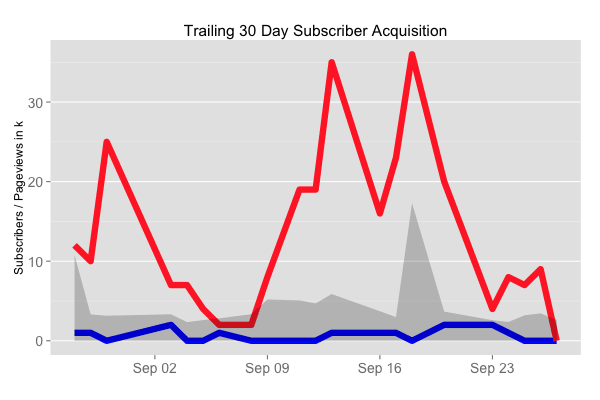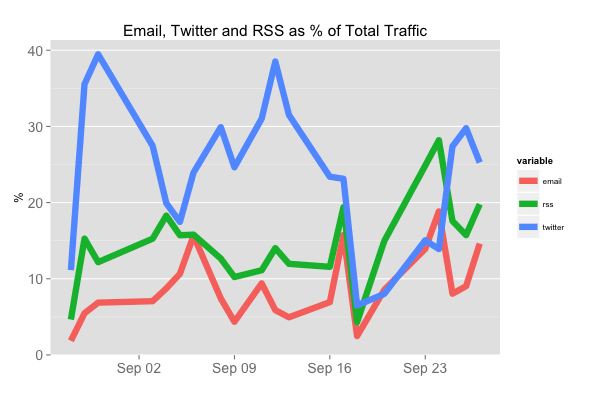The single best content marketing channel is email subscriptions powered by Twitter/social media distribution.
Thirty days ago, I began an experiment with this blog to determine whether email, Twitter or RSS would be the better content marketing channel. My goals with RSS, Twitter and email are two: first to maintain a relationship with a reader longer than a single website visit by creating a communication channel and second to use that marketing channel to drive re-engagement.
Below, I’ve analyzed the results and come across some surprising findings. First, RSS subscribers generate more traffic than email subscribers. Second, email readers are much easier to win than RSS readers. Third, email and RSS subscribers tend to be very different audiences and these channels do not cannibalize each other. Fourth, Twitter’s performance on a unit basis pales in comparison to its competition, but makes it up in volume.
Note, the code to perform a web, rss and email analysis is at the bottom of this post, in case you’re interested in analyzing your startup’s content marketing effectiveness.
Email and RSS Conversion Funnels
Email and RSS subscribers open blog posts at roughly equal rates; RSS is a moderate 21% better. But 2.5x more people click through to the website from RSS as from email. When RSS subscribers do come to the website, they browse about half as many pages as email subscribers. Net-net, the average RSS subscriber generates about 25% more page views than an email subscriber.
The most effective content marketing strategy is to combine Twitter’s distribution capacity with email’s conversion rates and broad applicability.
| RSS | Delta | |||
| Open Rate | 51% | 62% | n/a | 21% better for RSS |
| Click through to site | 23% | 80% | 4.5% | 250% better for RSS |
| Page views per visit | 2.3 | 1.2 | 2.0 | 91% better for email |
| Expected Page Views per 100 Subscribers | 127 | 159 | 9 | 25% better for RSS |
| Subscriber Volumes | 454 | 1567 | 9874 | 530% better for Twitter |
Other Interesting Data Points from the Analysis
- Absolutely no one forwards the Mailchimp emails. Of 6500+ emails sent, 0 were forwarded.
- On average, this blog acquires 13 new email subscribers daily which is roughly equal to the number of new organic Twitter followers added per day, 15 and about 4 times greater than the 4 new RSS subscribers per day in the same period. At current course and speed, I expect email to surpass RSS in 64 days' time.
- 0.3% of visitors to the blog subscribe via email. I don’t have a comparable RSS metric because of the way Feedburner collects these figures.
- 3% of email subscribers or about 13 people have unsubscribed in the past 30 days. Given that small volume, I assume no cannibalization and no overlap in user base with RSS which counts about 1500 subscribers.
- Email subscription growth has a weak correlation to traffic, only about 0.58 R2. This means that traffic spikes typically generate traffic that bounces - visits once and doesn’t return. I wish I could cookie users and understand how many impressions it takes to entice someone to become a subscriber.
- RSS CTRs are 3x greater than the emails, despite the fact that I syndicate full blog posts into the feed. I’m not sure what the driver is here,
The Story in Charts
Traffic is indicated in gray, new subscribers in red and unsubscribers in blue. Email signups are volatile and aren’t tightly coupled to traffic, meaning the blog fails to convert many new visitors driven by large volumes of retweets or HackerNews traffic spikes to subscribers. 
This chart shows share of traffic by channel. Email has grown from about 0 to 15% in 30 days. RSS is also growing and has reached about 20% of page views. Twitter represents about 23% of traffic. On an average day, about 55 to 60% of traffic is brought to this blog through reader marketing channels. The figures are incredibly volatile, however.
Perform this Analysis for Your Content
The Chimp project on Github contains all the R and Ruby code and instructions to replicate this analysis: https://github.com/ttunguz/chimp
